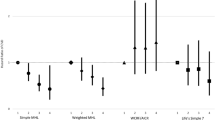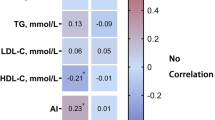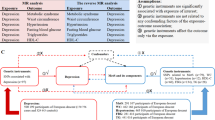Abstract
Background/Objectives:
Total homocysteine (tHcy) has been associated with increased risk of several diseases in the general population. It is not clear whether these associations are causal. A less healthy lifestyle as well as a less favorable biological risk factor profile have been related to increased tHcy in cross-sectional studies. In addition, the methylenetetrahydrofolate reductase (MTHFR) C677T gene variant is an important determinant of elevated tHcy. The main objective of the study was to examine the effect of changes in biological risk factors and lifestyle on tHcy in relation to MTHFR C677T genotype.
Subjects/Methods:
The study is a population-based study including 1805 men and women aged 30–60 years participating in a health examination at baseline (1999–2001) and at a 5-year follow-up examination.
Results:
Changes in tHcy were not associated with changes in dietary habits, physical activity, smoking status, coffee, tea, total alcohol or wine consumption. An inverse relationship was observed between changes in tHcy and changes in the intake of beer in TT individuals but not in CC/CT individuals (Pinteraction=0.01). In addition, changes in tHcy were positively associated with changes in several biological risk factors, such as waist circumference, diastolic blood pressure, total cholesterol and LDL cholesterol (P<0.01). The association between waist circumference and MTHFR genotype seemed stronger in TT individuals than in CC/CT individuals (Pinteraction=0.03).
Conclusions:
tHcy was not influenced by lifestyle changes except for the inverse association between beer consumption and tHcy observed in TT individuals. This suggests that tHcy is not a mediator in the causal pathway between lifestyle and lifestyle-related diseases such as cardiovascular disease in accordance with results of recent randomized trials. However, tHcy was related to changes in several biological risk factors, suggesting that tHcy may be a good predictor or marker of disease.
This is a preview of subscription content, access via your institution
Access options
Subscribe to this journal
Receive 12 print issues and online access
$259.00 per year
only $21.58 per issue
Buy this article
- Purchase on SpringerLink
- Instant access to full article PDF
Prices may be subject to local taxes which are calculated during checkout
Similar content being viewed by others
References
Aadahl M, von Huth Smith L, Pisinger C, Toft U, Glumer C, Borch-Johnsen K et al. (2009). Five-year change in physical activity is associated with changes in cardiovascular disease risk factors. The inter99 study. Prev Med 48, 326–331.
Beulens JW, Sierksma A, Schaafsma G, Kok FJ, Struys EA, Jakobs C et al. (2005). Kinetics of homocysteine metabolism after moderate alcohol consumption. Alcohol Clin Exp Res 29, 739–745.
Bleich S, Bleich K, Kropp S, Bittermann HJ, Degner D, Sperling W et al. (2001). Moderate alcohol consumption in social drinkers raises plasma homocysteine levels: a contradiction to the ′French Paradox′? Alcohol Alcohol 36, 189–192.
Bonaa KH, Njolstad I, Ueland PM, Schirmer H, Tverdal A, Steigen T et al. (2006). Homocysteine lowering and cardiovascular events after acute myocardial infarction. N Engl J Med 354, 1578–1588.
Boushey CJ, Beresford SA, Omenn GS, Motulsky AG (1995). A quantitative assessment of plasma homocysteine as a risk factor for vascular disease. Probable benefits of increasing folic acid intakes. JAMA 274, 1049–1057.
Brown KS, Kluijtmans LA, Young IS, Murray L, McMaster D, Woodside JV et al. (2004). The 5,10-methylenetetrahydrofolate reductase C677T polymorphism interacts with smoking to increase homocysteine. Atherosclerosis 174, 315–322.
Clarke R, Lewington S, Donald A, Johnston C, Refsum H, Stratton I et al. (2001). Underestimation of the importance of homocysteine as a risk factor for cardiovascular disease in epidemiological studies. J Cardiovasc Risk 8, 363–369.
Clarke R, Shipley M, Lewington S, Youngman L, Collins R, Marmot M et al. (1999). Underestimation of risk associations due to regression dilution in long-term follow-up of prospective studies. Am J Epidemiol 150, 341–353.
de Bree A, Verschuren WM, Blom HJ (2001a). Biological cardiovascular risk factors and plasma homocysteine levels in the general Dutch population. Atherosclerosis 154, 513–514.
de Bree A, Verschuren WM, Blom HJ, Kromhout D (2001b). Lifestyle factors and plasma homocysteine concentrations in a general population sample. Am J Epidemiol 154, 150–154.
Dedoussis GV, Panagiotakos DB, Chrysohoou C, Pitsavos C, Zampelas A, Choumerianou D et al. (2004). Effect of interaction between adherence to a Mediterranean diet and the methylenetetrahydrofolate reductase 677C → T mutation on homocysteine concentrations in healthy adults: the ATTICA Study. Am J Clin Nutr 80, 849–854.
Duthie SJ, Whalley LJ, Collins AR, Leaper S, Berger K, Deary IJ (2002). Homocysteine, B vitamin status, and cognitive function in the elderly. Am J Clin Nutr 75, 908–913.
El Khairy L, Ueland PM, Nygard O, Refsum H, Vollset SE (1999). Lifestyle and cardiovascular disease risk factors as determinants of total cysteine in plasma: the Hordaland Homocysteine Study. Am J Clin Nutr 70, 1016–1024.
Elshorbagy AK, Nurk E, Gjesdal CG, Tell GS, Ueland PM, Nygard O et al. (2008). Homocysteine, cysteine, and body composition in the Hordaland Homocysteine Study: does cysteine link amino acid and lipid metabolism? Am J Clin Nutr 88, 738–746.
Ford ES, Smith SJ, Stroup DF, Steinberg KK, Mueller PW, Thacker SB (2002). Homocyst(e)ine and cardiovascular disease: a systematic review of the evidence with special emphasis on case-control studies and nested case-control studies. Int J Epidemiol 31, 59–70.
Frosst P, Blom HJ, Milos R, Goyette P, Sheppard CA, Matthews RG et al. (1995). A candidate genetic risk factor for vascular disease: a common mutation in methylenetetrahydrofolate reductase. Nat Genet 10, 111–113.
Homocysteine Lowering Trialists′ Collaboration (1998). Lowering blood homocysteine with folic acid based supplements: meta-analysis of randomised trials. Homocysteine Lowering Trialists′ Collaboration. BMJ 316, 894–898.
Husemoen LL, Thomsen TF, Fenger M, Jorgensen HL, Jorgensen T (2003). Contribution of thermolabile methylenetetrahydrofolate reductase variant to total plasma homocysteine levels in healthy men and women. Inter99 (2). Genet Epidemiol 24, 322–330.
Husemoen LL, Thomsen TF, Fenger M, Jorgensen T (2004). Effect of lifestyle factors on plasma total homocysteine concentrations in relation to MTHFR(C677T) genotype. Inter99 (7). Eur J Clin Nutr 58, 1142–1150.
Husemoen LL, Thomsen TF, Fenger M, Jorgensen T (2006). Changes in lifestyle and total homocysteine in relation to MTHFR(C677T) genotype: the Inter99 study. Eur J Clin Nutr 60, 614–622.
Hustad S, Ueland PM, Vollset SE, Zhang Y, Bjorke-Monsen AL, Schneede J (2000). Riboflavin as a determinant of plasma total homocysteine: effect modification by the methylenetetrahydrofolate reductase C677T polymorphism. Clin Chem 46, 1065–1071.
Jacques PF, Bostom AG, Williams RR, Ellison RC, Eckfeldt JH, Rosenberg IH et al. (1996). Relation between folate status, a common mutation in methylenetetrahydrofolate reductase, and plasma homocysteine concentrations. Circulation 93, 7–9.
Jacques PF, Bostom AG, Wilson PW, Rich S, Rosenberg IH, Selhub J (2001). Determinants of plasma total homocysteine concentration in the Framingham Offspring cohort. Am J Clin Nutr 73, 613–621.
Jacques PF, Kalmbach R, Bagley PJ, Russo GT, Rogers G, Wilson PW et al. (2002). The relationship between riboflavin and plasma total homocysteine in the Framingham Offspring cohort is influenced by folate status and the C677T transition in the methylenetetrahydrofolate reductase gene. J Nutr 132, 283–288.
Jorgensen T, Borch-Johnsen K, Thomsen TF, Ibsen H, Glumer C, Pisinger C (2003). A randomized non-pharmacological intervention study for prevention of ischaemic heart disease: baseline results Inter99. Eur J Cardiovasc Prev Rehabil 10, 377–386.
Lonn E, Yusuf S, Arnold MJ, Sheridan P, Pogue J, Micks M et al. (2006). Homocysteine lowering with folic acid and B vitamins in vascular disease. N Engl J Med 354, 1567–1577.
McLean RR, Jacques PF, Selhub J, Tucker KL, Samelson EJ, Broe KE et al. (2004). Homocysteine as a predictive factor for hip fracture in older persons. N Engl J Med 350, 2042–2049.
Meleady R, Ueland PM, Blom H, Whitehead AS, Refsum H, Daly LE et al. (2003). Thermolabile methylenetetrahydrofolate reductase, homocysteine, and cardiovascular disease risk: the European Concerted Action Project. Am J Clin Nutr 77, 63–70.
Nurk E, Tell GS, Vollset SE, Nygard O, Refsum H, Nilsen RM et al. (2004). Changes in lifestyle and plasma total homocysteine: the Hordaland Homocysteine Study. Am J Clin Nutr 79, 812–819.
Nygard O, Refsum H, Ueland PM, Stensvold I, Nordrehaug JE, Kvale G et al. (1997). Coffee consumption and plasma total homocysteine: the Hordaland Homocysteine Study. Am J Clin Nutr 65, 136–143.
Nygard O, Refsum H, Ueland PM, Vollset SE (1998). Major lifestyle determinants of plasma total homocysteine distribution: the Hordaland Homocysteine Study. Am J Clin Nutr 67, 263–270.
Nygard O, Vollset SE, Refsum H, Stensvold I, Tverdal A, Nordrehaug JE et al. (1995). Total plasma homocysteine and cardiovascular risk profile. The Hordaland Homocysteine Study. JAMA 274, 1526–1533.
Panagiotakos DB, Pitsavos C, Zeimbekis A, Chrysohoou C, Stefanadis C (2005). The association between lifestyle-related factors and plasma homocysteine levels in healthy individuals from the ‘ATTICA’ Study. Int J Cardiol 98, 471–477.
Rasmussen LB, Ovesen L, Bulow I, Knudsen N, Laurberg P, Perrild H (2000). Folate intake, lifestyle factors, and homocysteine concentrations in younger and older women. Am J Clin Nutr 72, 1156–1163.
Saw SM, Yuan JM, Ong CN, Arakawa K, Lee HP, Coetzee GA et al. (2001). Genetic, dietary, and other lifestyle determinants of plasma homocysteine concentrations in middle-aged and older Chinese men and women in Singapore. Am J Clin Nutr 73, 232–239.
Schmölker L, Fagerstrom K (2000). Gram tobacco 2000. Personal communication.
Stein JH, Bushara M, Bushara K, McBride PE, Jorenby DE, Fiore MC (2002). Smoking cessation, but not smoking reduction, reduces plasma homocysteine levels. Clin Cardiol 25, 23–26.
Strandhagen E, Zetterberg H, Aires N, Palmer M, Rymo L, Blennow K et al. (2004). The methylenetetrahydrofolate reductase C677T polymorphism is a major determinant of coffee-induced increase of plasma homocysteine: a randomized placebo controlled study. Int J Mol Med 13, 811–815.
Thomsen TF, Davidsen M, Ibsen H, Jorgensen T, Jensen G, Borch-Johnsen K (2001). A new method for CHD prediction and prevention based on regional risk scores and randomized clinical trials; PRECARD and the Copenhagen Risk Score. J Cardiovasc Risk 8, 291–297.
Toft U, Kristoffersen LH, Lau C, Borch-Johnsen K, Jorgensen T (2007). The Dietary Quality Score: validation and association with cardiovascular risk factors: the Inter99 study. Eur J Clin Nutr 61, 270–278.
Tonstad S, Urdal P (2002). Does short-term smoking cessation reduce plasma total homocysteine concentrations? Scand J Clin Lab Invest 62, 279–284.
Toole JF, Malinow MR, Chambless LE, Spence JD, Pettigrew LC, Howard VJ et al. (2004). Lowering homocysteine in patients with ischemic stroke to prevent recurrent stroke, myocardial infarction, and death: the Vitamin Intervention for Stroke Prevention (VISP) randomized controlled trial. JAMA 291, 565–575.
van der Gaag MS, Ubbink JB, Sillanaukee P, Nikkari S, Hendriks HF (2000). Effect of consumption of red wine, spirits, and beer on serum homocysteine. Lancet 355, 1522.
Vickers AJ, Altman DG (2001). Statistics notes: Analysing controlled trials with baseline and follow up measurements. BMJ 323, 1123–1124.
Vollset SE, Refsum H, Irgens LM, Emblem BM, Tverdal A, Gjessing HK et al. (2000). Plasma total homocysteine, pregnancy complications, and adverse pregnancy outcomes: the Hordaland Homocysteine study. Am J Clin Nutr 71, 962–968.
von Huth SL, Borch-Johnsen K, Jorgensen T (2007). Commuting physical activity is favourably associated with biological risk factors for cardiovascular disease. Eur J Epidemiol 22, 771–779.
Wright M, Francis K, Cornwell P (1998). Effect of acute exercise on plasma homocysteine. J Sports Med Phys Fitness 38, 262–265.
Acknowledgements
We thank the participants, the Steering Committee (Torben Jørgensen (principal investigator), Knut Borch-johnsen (co-principal investigator), and Charlotta Pisinger), and all the members of the Inter99 staff at the Research Centre for Prevention and Health, Glostrup, Denmark and the Steno Diabetes Center, Gentofte, Denmark
Author information
Authors and Affiliations
Corresponding author
Additional information
Contributors: LLNH, TJ and AL contributed to the development of hypothesis and study design. TJ was the principal investigator of the inter99 study and responsible for data collection. LLNH performed the genotype analyses in collaboration with MF. LLNH and AL performed the statistical analyses. LLNH wrote the first draft and coordinated the completion of the paper. AL, TJ, MF and BHT contributed to the interpretation of results, the revision of the paper and have approved the final version of the paper.
Rights and permissions
About this article
Cite this article
Husemoen, L., Linneberg, A., Fenger, M. et al. Changes in lifestyle, biological risk factors and total homocysteine in relation to MTHFR C677T genotype: a 5-year follow-up study. Eur J Clin Nutr 63, 1233–1240 (2009). https://doi.org/10.1038/ejcn.2009.59
Received:
Revised:
Accepted:
Published:
Issue date:
DOI: https://doi.org/10.1038/ejcn.2009.59
Keywords
This article is cited by
-
Mendelian randomisation study of the associations of vitamin B12 and folate genetic risk scores with blood pressure and fasting serum lipid levels in three Danish population-based studies
European Journal of Clinical Nutrition (2016)
-
Enrichment of MTHFR 677 T in a Chinese long-lived cohort and its association with lipid modulation
Lipids in Health and Disease (2014)
-
MTHFR C677T genotype and cardiovascular risk in a general population without mandatory folic acid fortification
European Journal of Nutrition (2014)
-
Fast analysis of wine for total homocysteine content by high-performance liquid chromatography
Amino Acids (2012)



